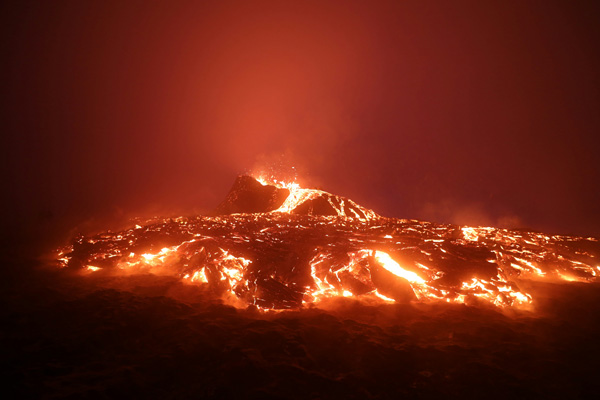Iceland’s volcano erupts again, spewing lava and smoke over Grindavik

[Image of a volcano eruption. Credit to Unsplash]
A volcano in southwestern Iceland erupted on May 29th, marking the fifth time since December 2023, spewing smoke and lava and posing a significant threat to the coastal town of Grindavik.
The eruption began at approximately 12:46 p.m. local time, following a series of earthquakes that occurred in the north of Grindavik, a small seaside fishing town with a population of around 3800.
An intense flow of lava surrounded Hagafell volcano to the east and then south towards the Melhólsnáma mine, according to the Icelandic Meteorological Office (IMO).
The volcano came to life in December after being dormant for several centuries.
Scientists stated that at one point, a dark plume of ash boiled up over the crater from an explosive interaction of magma hitting groundwater.
The IMO described this eruption as the area’s most powerful so far, as lava shot 165 feet into the sky from a fissure that grew to 2.1 miles in length.
The barriers constructed to protect Grindavik diverted the flowing lava, cutting off two of the three roads leading to the town.
The police announced orders that residents of the town should leave earlier in the day, but three people refused to leave.
For the third time in the past two months, people were forced to evacuate from the country’s biggest tourist attraction, the Blue Lagoon geothermal spa.
Both international and domestic flights continued since the cloud did not rise high enough to pose an immediate threat to aviation.
Electricity to Grindavik was cut as a protective measure as lava flows approached high-voltage lines and hot and cold pipes in the ground.
Grindavik, located 50 km southwest of the Icelandic capital, Reykjavik, has been threatened since a series of earthquakes in November led to most residents permanently evacuating in advance of the initial eruption that occurred on December 18.
Subsequent eruptions occurred in January, February and March.
The February 8 eruption notably caused heat and hot water to be cut off to thousands of people.
The volcanic activity has disrupted district heating, closed key roads, and razed several homes in the Grindavik fishing town, with only a few residents returning since the evacuation in late 2023.
The area is part of the Svartsengi volcanic system, which remained dormant for nearly 800 years before reawakening.
Iceland, situated above a volcanic hot spot in the North Atlantic, is one of the most active volcanic areas on the planet.
The country has 33 active volcano systems and sits over the Mid-Atlantic Ridge which is the boundary between two of the largest tectonic plates on Earth.
Given that this was the eighth eruption since 2021, scientists believe the area is entering a new volcanic era that could persist for decades or even centuries.
Currently, air quality meters are ‘green’ across Iceland, indicating that there is currently no air pollution from the eruption.
Nevertheless, Iceland’s national police warned that westerly wind could carry gas pollution eastward which might affect areas in South Iceland.

- Chaemin Lee / Grade 10
- Saint Paul Academy Daechi

![THE HERALD STUDENT REPORTERS [US]](/assets/images/logo_student_us.png)
![THE HERALD STUDENT REPORTERS [Canada]](/assets/images/logo_student_ca.png)
